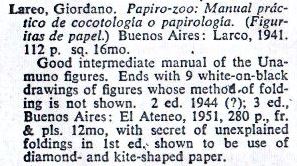The Public Paperfolding History Project Last updated 12/2/2025 x |
||||||||
| Third Edition of Papiro-Zoo: Manual Practico de Papirologia o Cocotologia by Giordano Lareo, 1951 | ||||||||
The Third edition of 'Papiro-Zoo: Manual Practico de Papirologia o Cocotologia' by Giordano Lareo was published by Libraria 'El Ateneo' Editorial in Buenos Aires in 1951. As far as I can tell this edition retains all the material from the 1944 second edition but also explains two additional designs, El Pelicano (added to the Fourth Part) and El Faisan (added as a Sixth Part) (see Analysis below). You can find some details of the 1941 first edition here. You can find some details of the 1944 second edition here. There is no statement from the author to the effect that any of the designs in the work are his own original creations. However, it seems likely that, apart from the simple designs in the first part, the Flapping Bird, and possibly the Peacock (which, following Legman, is usually attributed to Solorzano), this is the case. Each of the designs in the second to sixth parts is accompanied by information about the animal in question, its nature and habitat etc. This information has not been recorded on this page since it is not germane to an understanding of paperfolding history. There is also a Seventh Part about the regions of the world which bears no relevance to the paperfolding content. ********** This work is mentioned in Gershon Legman's 'Bibliography of Paperfolding' which was published in 1952.
**********
********** The work also contains two black and white photographs. The figure of a horse and rider in the bottom middle of the left hand photo is not mentioned elsewhere in the work but is one of the 'Figuras varias' pictured in the 1941 first edition.
**********
********** Analysis Designs which are new to this edition Fourth Part El Pelicano
********** Sixth Part - a design from an irregular pentagon El Faisan This design is developed from a 19.5 x 11 rectangle which has been cut into a point using two 45 degree cuts at one end. It is a development of the Pavo Real design.
********** |
||||||||








